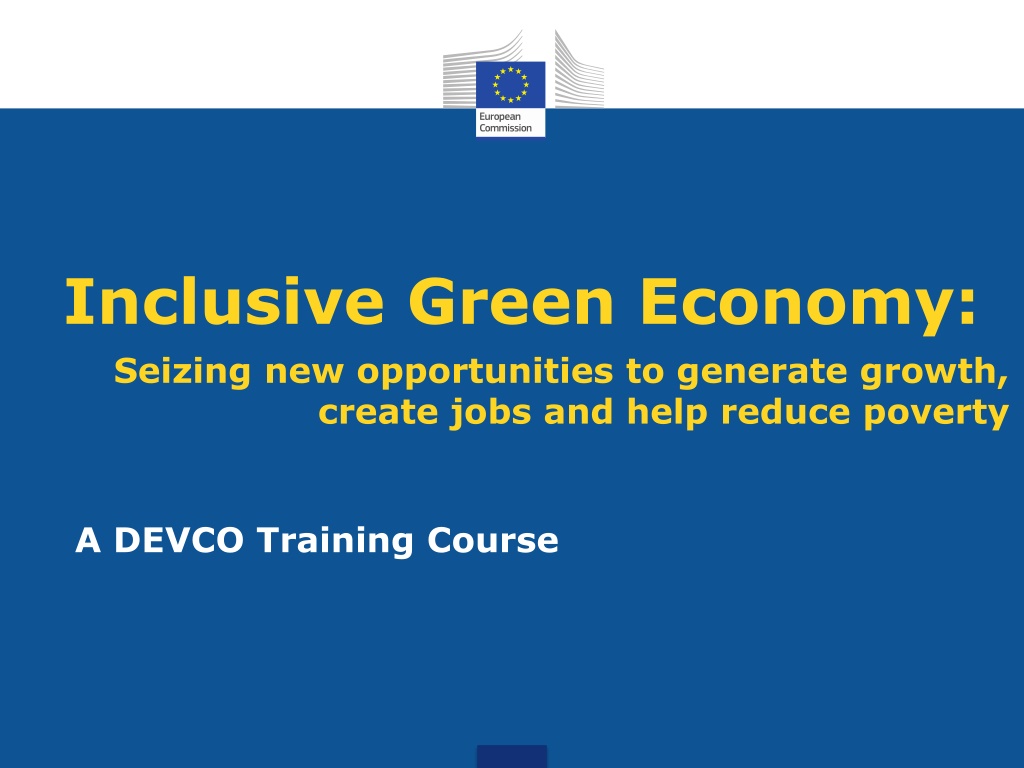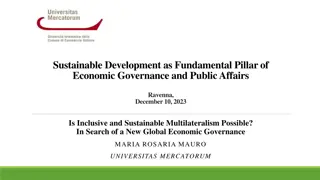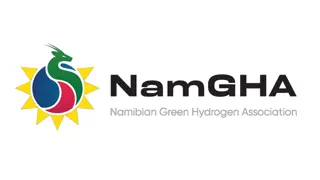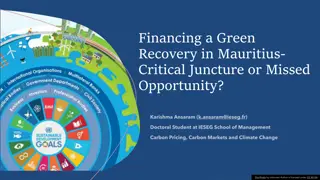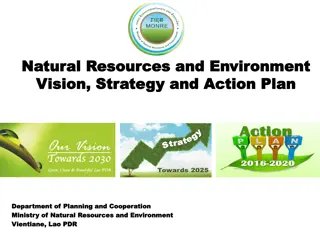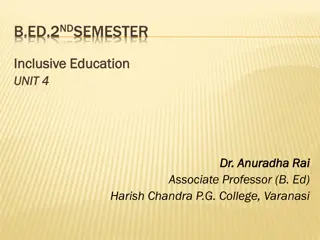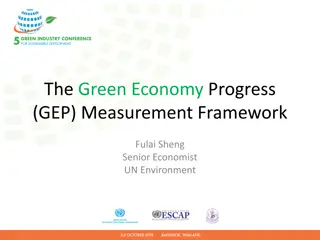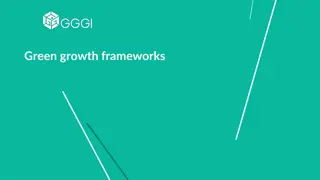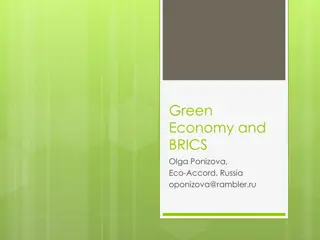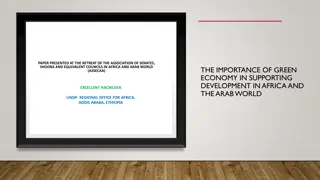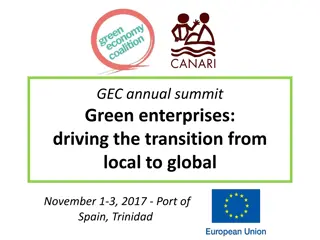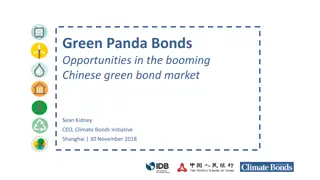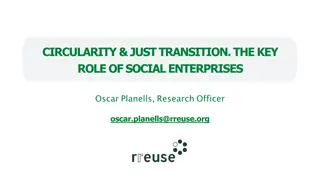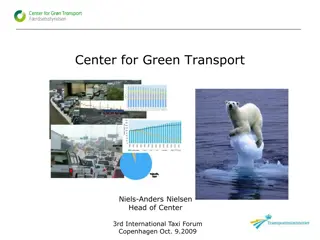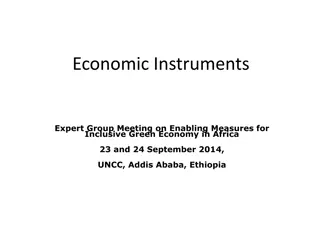Understanding the Inclusive Green Economy for Sustainable Development
Embrace the concept of an Inclusive Green Economy to create opportunities for growth, job creation, poverty reduction, and sustainable development. Learn the key principles, processes, and approaches of transitioning towards a greener economy, focusing on social and environmental sustainability. Explore how this economic model can promote prosperity for all while preserving natural capital and reducing inequalities.
Download Presentation

Please find below an Image/Link to download the presentation.
The content on the website is provided AS IS for your information and personal use only. It may not be sold, licensed, or shared on other websites without obtaining consent from the author. Download presentation by click this link. If you encounter any issues during the download, it is possible that the publisher has removed the file from their server.
E N D
Presentation Transcript
Inclusive Green Economy: Seizing new opportunities to generate growth, create jobs and help reduce poverty A DEVCO Training Course
Understanding Inclusive Green Economy Module 2:
Objectives of Module 2: Define inclusive green economy: Introduce concepts and highlight key principles and processes of an inclusive green transformation Consider inclusive green economy approaches by developing countries and understand the transition process in the context of development cooperation
What is an Inclusive Green Economy?
Inclusive Green Economy: A pathway to Sustainable Development Economic Development Inclusive Growth Green Growth Social Environmental Sustainability Development An inclusive green economy that can reduce povertyand inequality and sustain growth for all Adapted graph based on UNDP (2013)
EC Perspective An economy that can secure growth and development, while at the same time improving human well-being, providing decent jobs, reducing inequalities, tackling poverty and preserving the natural capital upon which we all depend. Commission Communication Rio+20: towards the green economy and better governance COM (2011) 363 adopted on 20 June 2011
More definitions similar perspective Social equity and ecological risk reduction Social inclusion / justice and decent work Natural assets resources & services Prosperity for all within one planet limits
Inclusive Green Economy as an economic model Traditional vs Green economics Environmental and social externalities GDP growth Biosphere Waste Pollution Ecosystems economy s building block Resource efficiency Human development Long term economic growth Ecosystem services Resources Circular flow on income Biosphere
Related economic models Circular Economy Source: DG Environment Low-carbon Economy
Inclusive Green Economy processes Green Economy Approaches Tools 1. Greening the brown economy Sustainable development 2. Growing the green economy Opportunities Safeguarding Innovative business models Address environmental concerns from initial stages of product design Eliminate environmental destruction cradle to cradle Reduce, Reuse, Recycle Slow down environmental destruction cradle to grave Adapted from C.Pasca Palmer: Growing the green economy in transitioning economies (CIERP, Tufts University (USA), 2009)
Inclusive Green Economy Entrepreneurship on the Ground https://www.youtube.com/watch?v=0wFbo8pGNw8
Challenges towards inclusive green economy can be global but also local!
Inclusive Green Economy for the LDCs Reliance on natural capital assets Existence of sustainable practices Opportunity to jump start the transition Challenge of creating links with global value chains Large potential for renewable energies
Making Inclusive Green Economy Work for the Poor Entry points: Low carbon, organic sustainable agriculture Improved off-grid green energy sources Fiscal mechanisms to foster pro-poor environmental change Poverty reduction through greening the tourism sector (Based on the Poverty-Environment Partnership 2013)
Inclusive Green Economy transition options Related with country objectives Based on national context, such as: country comparative advantages, structure of the economy Access to natural and/or financial resources No one-size-fits-all solutions
Inclusive Green Economy transition: Country examples - Ethiopia Vision for climate resilient green economy: fostering growth and economic development; managing GHG emissions; and improving resilience to climate change (CC) Initial focus on: CC Institutions Monitoring and finance systems Sector and regional action plans Water and Energy implementation priorities
Inclusive Green Economy transition: Country examples - Kenya Green Economy Strategic objectives: Promoting sustainable infrastructure Building Resilience Sustainable Natural Resource Management Promoting Resource Efficiency Social Inclusion and Sustainable Livelihoods Sector specific policy opportunities for: Agriculture: agroforestry, sustainable water management, etc. Energy: distributed clean energy solutions, etc. Manufacturing: eco-labelling of manufacturing products, etc. Transport: mass transit promotion, etc.
Key Messages of Module 2 Inclusive green economy is a realistic approach to achieve sustainable development. Towards an inclusive green economy, challenges and opportunities for developing and developed countries are equally important, though not always similar. There is no standard pathway towards inclusive green economy, as the transformation process needs to be adjusted to the specific context of each target area.
References Commission Communication Rio+20: towards the green economy and better governance COM (2011) 363 adopted on 20 June 2011 UNDP (2013) Inclusive Green Economy Contribution to Sustainable Development Chart p.6 UNEP (2011) Towards a Green Economy: Pathways to Sustainable Development and Poverty Eradication, Report. Available at: http://www.unep.org/greeneconomy/GreenEconomyReport/tabid/29846/Default.aspx CNBC Africa (2012) Pacesetter: Lorna Rutto, Founder of Ecopost, Video available at: https://www.youtube.com/watch?v=0wFbo8pGNw8 Green Economy Coalition (2012) Principles of an Inclusive Green Economy Transition. Available at: http://www.greeneconomycoalition.org/ UN DESA (2012) Inclusive Green Economy Principles. UN (1987) Report of the World Commission on Environment and Development: Our Common Future. UN, New York. RSC (2016) Regions for sustainable change. Website available at: http://www.rscproject.org/ OECD (2010) Transition to a Low-carbon Economy: public goals and corporate practices. Available at: http://www.oecd.org/corporate/mne/transitiontoalow-carboneconomy.htm OECD (2011) Towards Green Growth. OECD, Paris. UNESCAP (2001) Green growth approach: experiences in mainstreaming disaster risk reduction and climate change adaptation. Chart on p.23 adapted from C.Pasca Palmer: Growing the green economy in transitioning economies (CIERP, Tufts University (USA), 2009) SWITCH-Asia Network Facility (2010) Switch-On-Poverty.mpg. Video available at: https://www.youtube.com/watch?v=1icOCnJq394&feature=player_embedded
